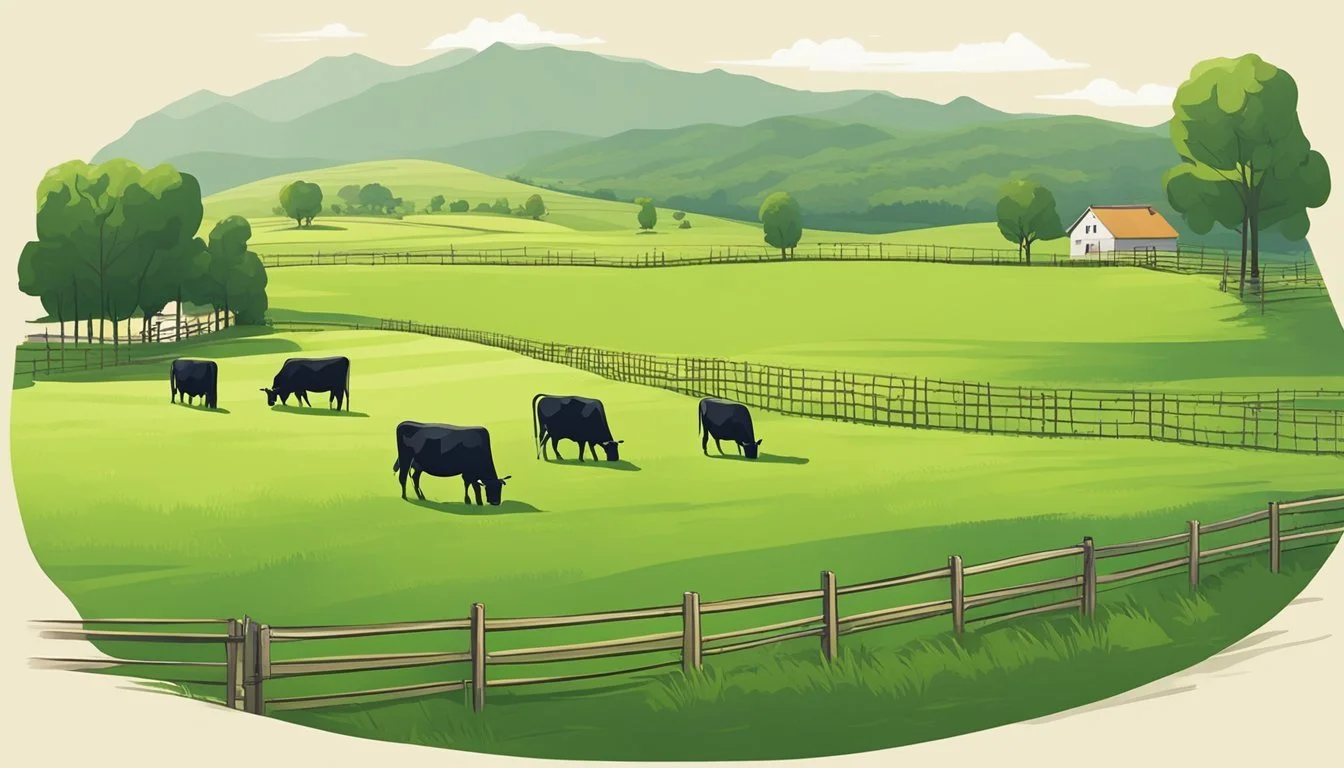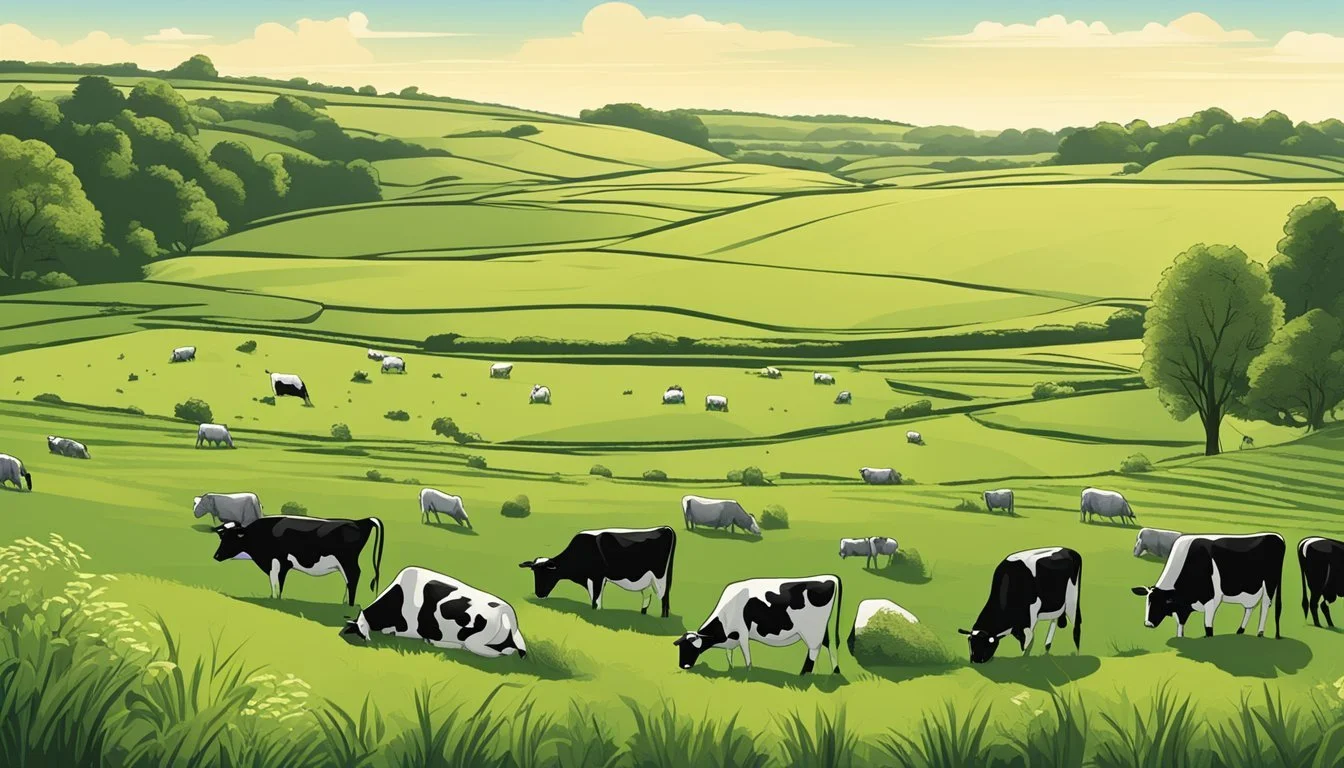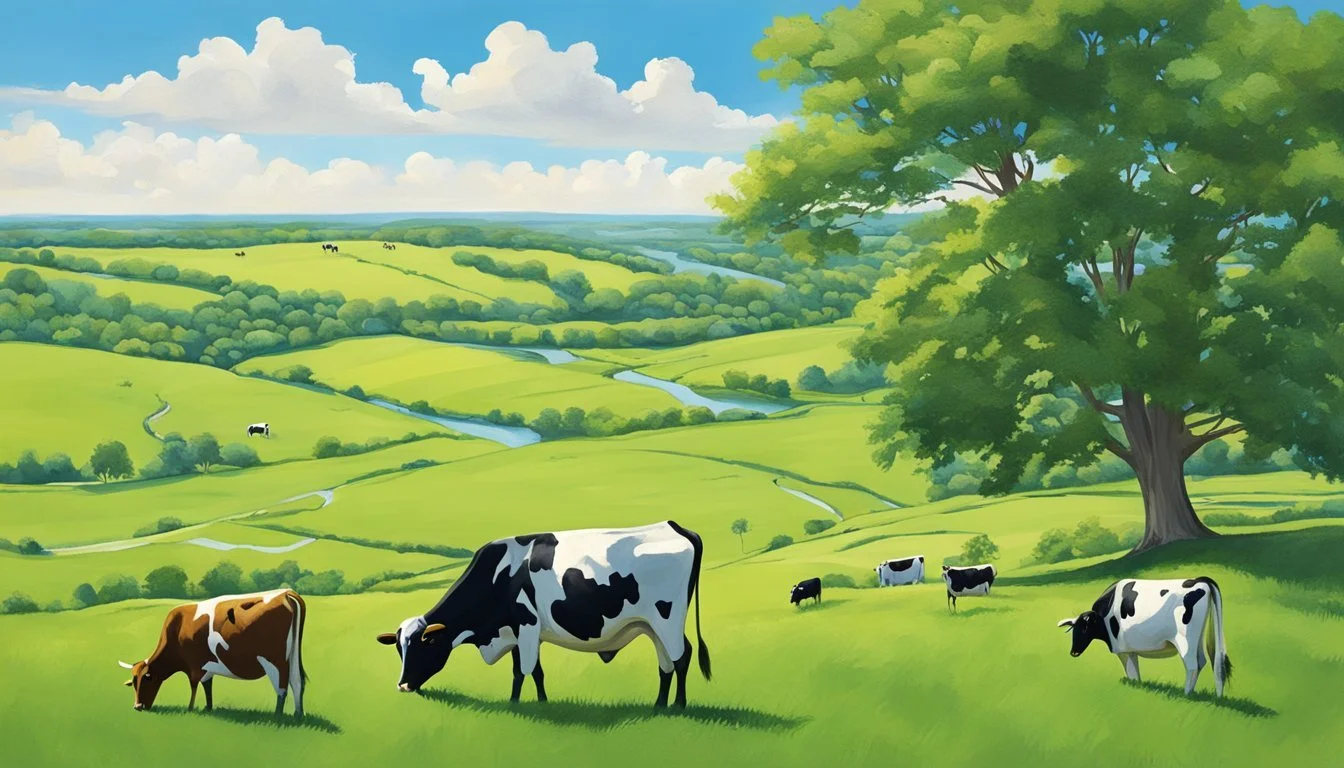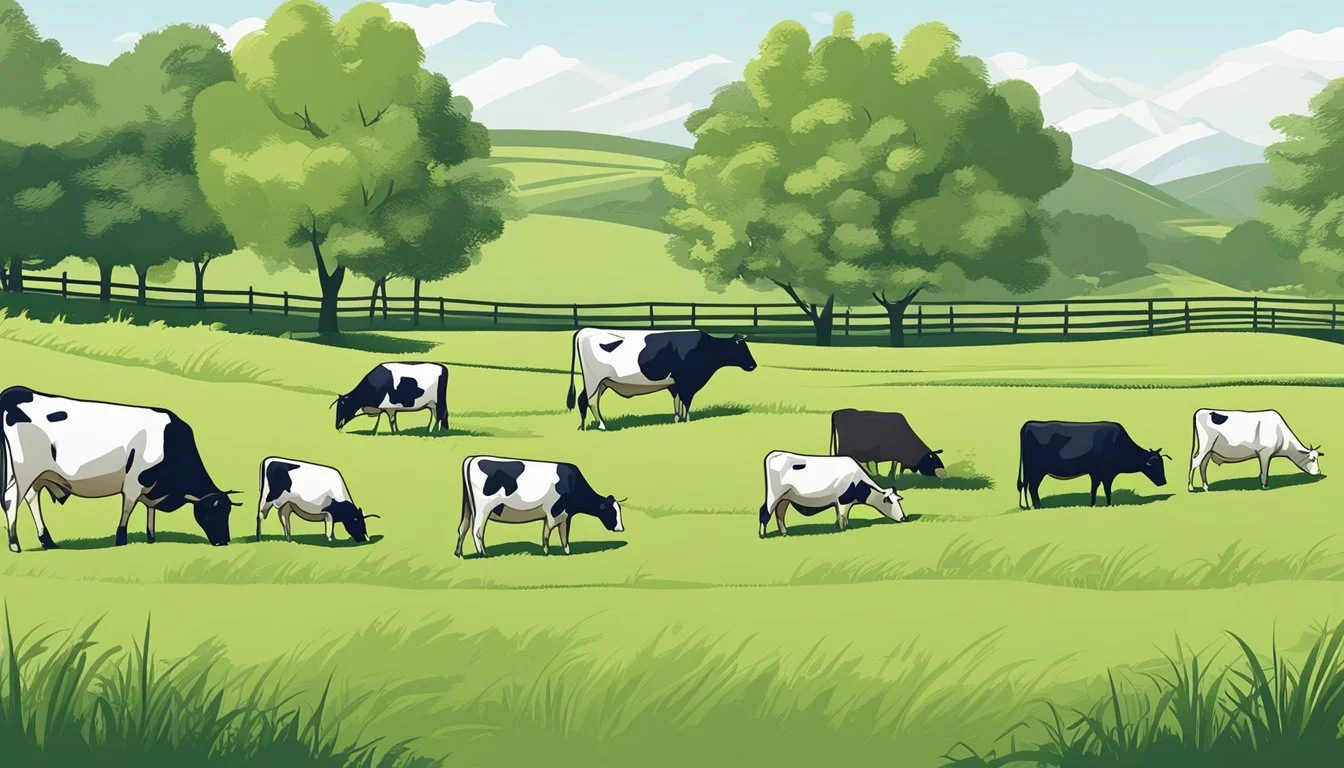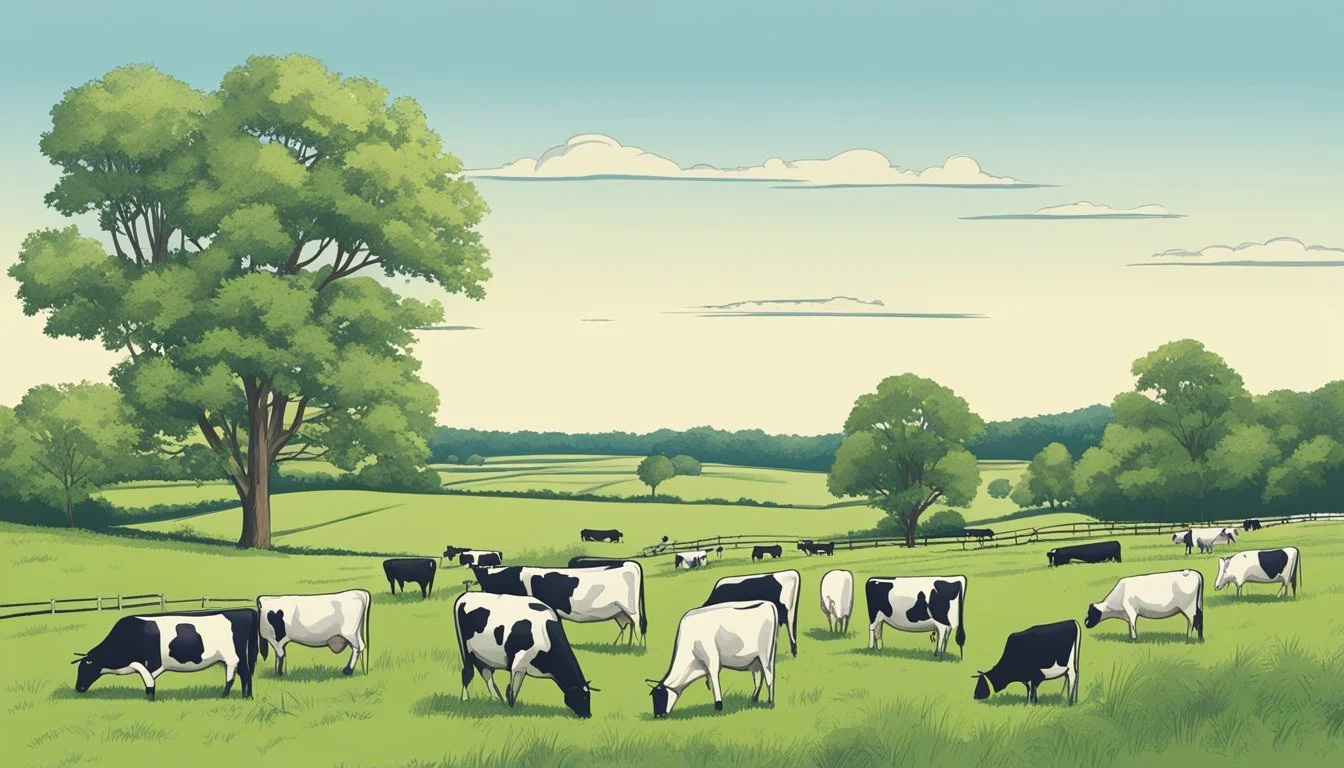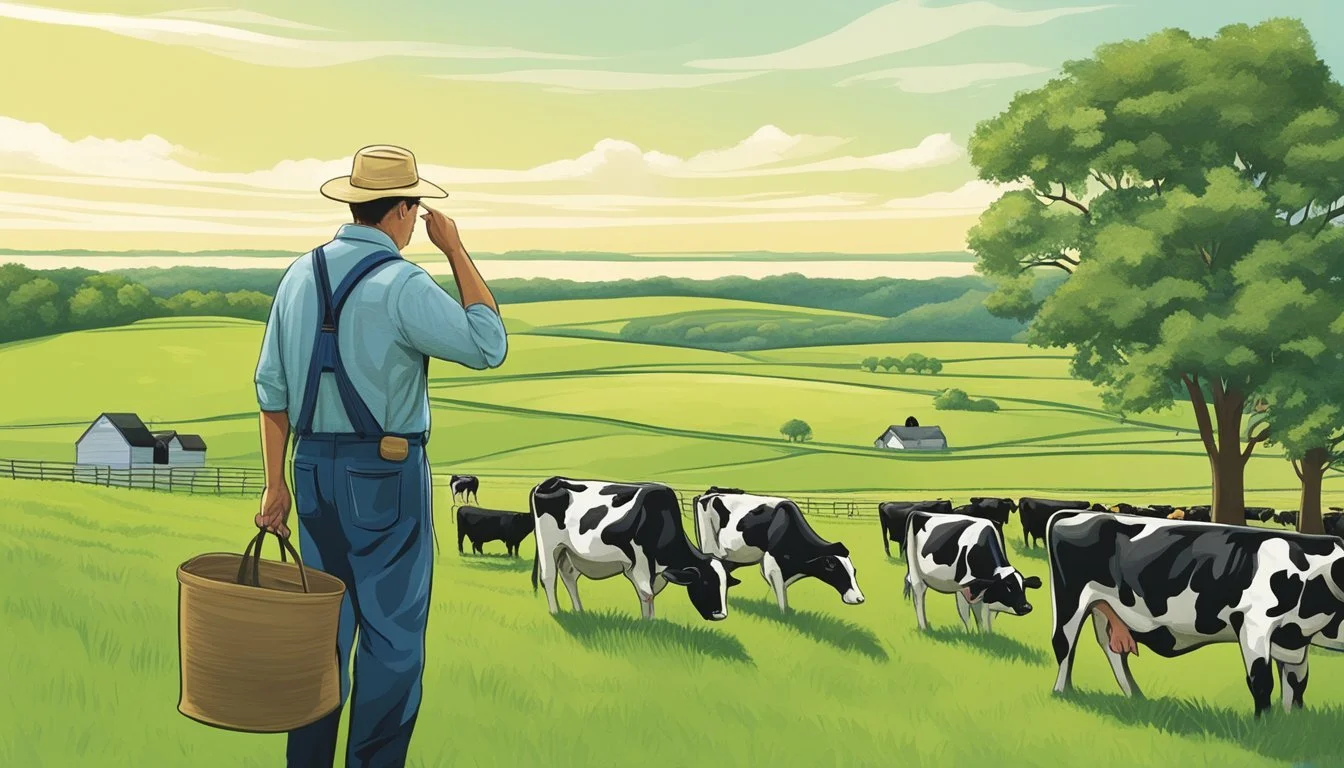Stocking Rate Rhode Island
Determining Cows Per Acre Capacity
Determining the appropriate stocking rate for cattle is a critical decision for livestock producers in Rhode Island. The stocking rate, or the number of cows an area can support without negative impacts, varies based on several factors including land quality, forage availability, and management practices. In Rhode Island, where pastures can vary from one farm to another, understanding how many cows per acre a property can support ensures sustainable grazing, animal performance, and pasture health.
Local conditions such as soil type, rainfall, and climate influence pasture productivity in Rhode Island, thus affecting stocking rates. The concept of Animal Units (AU) helps standardize stocking rates, with one AU equivalent to one 1,000-pound cow. Estimations of the carrying capacity can start with general figures but must be refined considering the specific characteristics of the pastureland. For instance, productive irrigated land may support more animals per acre compared to non-irrigated or poorer quality pastures.
Producers must assess their pastures regularly and adjust the number of cows accordingly to avoid overgrazing and to maintain the land's ecological balance. Using techniques such as rotational grazing can improve pasture use and increase stocking capacity. Strategic management ensures that the land continues to be productive for years to come, making efficient land use crucial in the relatively small state of Rhode Island.
Fundamentals of Stocking Rate
The ability of land to support livestock, such as cattle, hinges on the stocking rate—assessing this plays a pivotal role in cattle management and conservation of forage resources.
Defining Stocking Rate and Animal Unit
Stocking rate is typically measured by the number of Animal Units (AUs) per acre that the land can sustainably support. One Animal Unit is defined as a 1,000-pound cow or its equivalent based on forage requirements. This calculation helps farmers and ranchers quantify the necessary land needed for proper livestock management, ensuring animals have adequate forage.
Importance of Stocking Rate in Cattle Management
The stocking rate directly influences the health of cattle and the land they graze on. It is essential for balancing livestock with available forage, maintaining healthy soils, and achieving the desired level of animal performance. Overstocking can lead to overgrazing, soil erosion, and degradation of pasture quality, while understocking may result in underutilized resources.
Factors Influencing Stocking Rate
Several factors determine the optimal stocking rate, including:
Forage Type and Availability: The quality and quantity of available forage directly affect how many cows per acre the land can support. For instance, irrigated pastures can support more cows per acre than unirrigated rangelands.
Land Size and Topography: Smaller parcels or lands with challenging terrain may reduce the effective stocking rate.
Climate and Seasonal Variations: Changes in weather patterns impact forage growth, influencing annual stocking rates.
Management Practices: Rotational grazing and land improvements can enhance the carrying capacity of the land.
Decisions regarding stocking rate should take these variables into account to support sustainable livestock operations.
Understanding Rhode Island's Agronomy
Determining the number of cows a property in Rhode Island can support requires an understanding of the local agronomy, including climate, soil quality, and forage types, which significantly influence pasture productivity and stocking rates.
Climate Impact on Forage Production
Rhode Island's climate, characterized by mild summers and cold winters, influences forage growth cycles and productivity. The state's precipitation pattern supports pasture growth predominantly in the spring and fall. Summer droughts and winter freezes necessitate careful planning to ensure year-round forage availability for grazing animals. Farmers must consider local weather trends, such as precipitation and temperature fluctuations when managing pastureland to optimize forage production and support sustainable stocking rates.
Soil Quality and Fertility
Rhode Island features a variety of soil types ranging from sandy loams to heavy clays. Soil quality and fertility are pivotal for robust forage growth. Regular soil testing is essential to determine nutrient levels and pH balance, which can impact soil fertility and the ability to support desirable forage species. Practices such as crop rotation, cover cropping, and mindful fertilization enhance soil health and productivity. Avoiding soil compaction through appropriate grazing management and equipment use is also crucial for maintaining soil structure and health.
Common Forage Types and Their Productivity
Common forage types in Rhode Island include a mix of grasses, legumes, and clover varieties, each with its own growth pattern and yield potential. Grasses such as tall fescue and orchardgrass are prevalent, while legumes like alfalfa and clovers add nitrogen to the soil, improving soil fertility and forage quality. The productivity of these forages largely depends on the location and maintenance of the pasture. Integrating legumes with grasses can increase forage yield and quality, supporting a higher stocking rate while also benefiting soil health.
With the right agronomic practices tailored to Rhode Island's unique conditions, farmers can maximize their land's potential to sustainably support livestock.
Carrying Capacity and Land Assessment
Properly evaluating the carrying capacity of a property in Rhode Island requires considering both land size and forage quality. This assessment ensures livestock needs are met without degrading land resources.
Evaluating Property Size and Forage Availability
Property owners must first measure the total area of their land in acres to assess its agricultural potential. Next, it's crucial to examine the forage type and growth on the property since these factors greatly influence how many cows the land can support. The quality of forage affects nutritional availability, which in turn dictates the health and productivity of the cattle.
Calculating Animal Units Per Acre
Forage demand is often measured in Animal Units (AUs), where one AU represents the forage needed by a 1,000-pound cow in one month. In Rhode Island, the acreage needed per AU can vary based on forage quality and quantity. To calculate the AUs an acre can support, one must estimate the average pounds of forage per acre and account for the intended harvest efficiency rate, which is the percentage of forage that the cattle will actually consume.
Managing Forage Demand and Supply
Sustainable stocking rates safeguard against overgrazing, which is critical to maintaining land and forage health. Balancing forage demand with supply involves routine monitoring and adjusting the stocking rate as necessary. Seasonal changes and erratic weather patterns, which can affect forage growth, should be anticipated. Effective management aims for a harmonious balance between the land's resources and the cattle's requirements to promote long-term productivity and ecological health.
Grazing Management Practices
Effective grazing management practices are essential for maximizing the productivity of a pasture while ensuring sustainability and the health of the land and livestock. This section outlines specific techniques and practices to support these objectives.
Rotational Grazing Techniques
Rotational grazing involves dividing a pasture into smaller areas, called paddocks, and moving livestock between them as needed. This method allows forage plants to recover between grazing periods, improving grazing efficiency. For example:
Movement Schedule: Animals might graze a paddock for three to seven days before moving to the next.
Rest Period: Each paddock typically has a rest period of 20 to 30 days to allow for regrowth.
Maintaining Pasture Quality and Health
The health of the pasture is critical for supporting livestock and sustaining a productive grazing system. Pasture quality can be maintained through:
Soil Testing: Regular soil tests can determine nutrient deficiencies.
Fertilization: Appropriate fertilization, based on soil test results, supports robust forage growth.
Weed Control: Systematic weed control strategies, such as mowing or herbicide application, prevent invasive species from diminishing forage quality.
Addressing Overgrazing and Undergrazing
Overgrazing and undergrazing both pose risks to pasture sustainability:
Overgrazing: Reduces plant vigor, root depth, and forage availability. It can be identified by short grasses less than 3 inches tall.
Undergrazing: Can lead to mature, less palatable grasses, reducing nutritional value and grazing efficiency. Overgrown pastures often see a build-up of plant material, which can smother new growth.
Effective grazing management continuously monitors pasture conditions, adjusting stocking rates and grazing periods as needed to maintain balance.
Supplementation and Forage Improvement Strategies
Effective supplementation and forage improvement strategies are essential in ensuring that a property can optimally support its livestock. They focus on enhancing forage quality, incorporating supplements, and managing pasture composition to meet the dietary needs of cows.
Use of Supplements and Silage
When pasture resources are insufficient, supplements can provide necessary nutrients that forage alone may lack. Supplementation with silage, which is preserved pasture or high-moisture content feed, can enhance the diet of cattle during periods of forage scarcity or low quality. To prevent adverse effects on forage utilization, cereal grain supplements should be kept to a maximum of 0.25% of cattle body weight. Protein supplements are often needed when forage protein content is low, and should be administered based on the specific requirements of the herd.
Incorporating Legumes and Nitrogen-Fixing Plants
Inclusion of legumes and other nitrogen-fixing plants in pastures can naturally enrich soil quality, improve forage availability, and reduce the need for chemical fertilizers. Legumes like alfalfa and clover can elevate the protein content of forage, thus potentially reducing the need for protein supplements. They also contribute to the overall health and productivity of grazing lands through biological nitrogen fixation, enhancing soil fertility, and providing high-quality forage.
Forage Quality Enhancement Techniques
Improvement of forage quality is critical for sustaining high stocking rates. Techniques include rotational grazing, reseeding with high-yield forage types, and strategic mowing to control plant maturity and promote new growth. Pasture managers aim for a balance that maintains forage density, optimizes nutritional value, and promotes animal health and productivity. Regular soil testing and visual assessments serve to guide the implementation of these techniques, ensuring forage remains at an optimal stage for grazing.
Economic and Profitability Considerations
The economic viability of a cattle operation pivots largely on finding the appropriate balance in stocking rates that will optimize profits while also minimizing potential risks to revenue.
Maximizing Profits through Stocking Rate Optimization
Stocking rate optimization refers to the strategic adjustment of the number of cows per acre to align with the productivity of the land while considering the cost of additional inputs. Research suggests that a lower stocking rate, that is fewer acres required per cow, can point to greater efficiency. It is critical for farmers to find this balance, as it directly impacts profitability.
Costs of Overstocking and Understocking
Overstocking can lead to pasture degradation and increased feed costs, whereas understocking may result in underutilized resources, both scenarios negatively affecting a farm's bottom line. The key is to determine an optimal stocking density that maximizes pasture use without damaging it, thus preserving future profits.
Overstocking costs:
Reduced pasture quality
Increased supplemental feed
Health issues in cattle
Understocking costs:
Lost income potential
Inefficient land use
USDA Economic Research and Data
The USDA Economic Research Service provides valuable data that can guide farmers in making informed decisions about stocking density and profitability. Their research includes cost estimates, market trends, and evaluations of farm management practices that are crucial for a profitable cattle operation. This data can be used to project future profitability and adjust stocking rates accordingly.
Operational Efficiency and Record Keeping
In Rhode Island, maximizing the number of cows per acre requires a strategic approach to operational efficiency and meticulous record keeping. These practices ensure optimal use of resources and data-driven decision-making.
Improving Stocking Rates with Efficient Operations
Efficient farming operations can profoundly influence the stocking rate. By adopting systematic rotational grazing or other advanced pasture management strategies, farmers can potentially increase harvest efficiency. For example, Rhode Island's pastureland could support more livestock per acre if grazing is managed in a way that promotes forage regrowth and soil health. Regular soil testing and pasture assessments can pinpoint the exact nutrient requirements, avoiding wastage of resources and improving the efficiency of forage production.
Accurate Record Keeping for Better Management
Record keeping is the backbone of effective herd and pasture management. By maintaining detailed records of livestock health, forage yields, and grazing patterns, farmers can monitor trends and make informed decisions. Such records might include:
Livestock Health Logs: Key indicators like weight gain, reproduction rates, and morbidity
Forage Yields: Periodic measurements of biomass to calculate available forage
Grazing Patterns: Tracking the movement of cows to ensure even grazing and pasture rest periods
Utilizing Technological Advances in Stocking Rate Calculations
Advancements in agricultural technology are revolutionizing how stocking rates are calculated and optimized. Geographic Information System (GIS) tools and satellite imaging can deliver precision mapping of pastures, revealing variations in forage quality and quantity. Additionally, software for data analysis can process historical records alongside real-time data, giving farmers insights into how many cows their acreage could support under various scenarios and management practices. By embracing these technologies, Rhode Island farmers can enhance their operational efficiency and effectively manage their stocking rates.
Contextual Factors and Special Considerations
Effective livestock management on Rhode Island properties requires understanding several environmental and biological factors that can significantly influence stocking rates. These considerations are critical for maintaining a sustainable operation.
Adapting to Seasonal Changes and Drought
Livestock farmers must monitor and adapt their management practices in response to the dynamic New England climate. During winter, they need to ensure that there is adequate feed as grass growth is minimal, thereby reducing the carrying capacity of the land. In times of drought, a proactive reduction in stocking rates can prevent overgrazing and preserve soil health. Regular assessment of forage availability throughout the grazing season is imperative to adjust stocking rates accordingly.
Tailoring Practices to Different Livestock Types
Different livestock have varying forage requirements. For example, milk producing animals such as dairy cattle typically require more nutrition than those raised for beef. Sheep and goats can thrive on pasture with a mix of grasses and brush, potentially aiding in the control of undesirable plants. It's crucial to balance the type and number of animals with the productive capacity of the pasture to avoid overuse.
Dealing with Pests and Undesirable Plant Species
Effective management of pests and undesirable plants is necessary to maintain the health and productivity of pastures. Farmers need to identify and control invasive species that can compromise the quality of forage and reduce the land's carrying capacity. Additionally, they must work towards creating a pasture environment that favors desirable forage species both to feed their livestock adequately and to outcompete the undesirable vegetation.

